
The Cathedral Church of St. Paul is the cathedral church of the Episcopal Diocese of Michigan. In 1824 its congregation formed as the first Episcopal and first Protestant church in Michigan Territory.

The Bonstelle Theatre is a theater operated by Wayne State University, and located at 3424 Woodward Avenue in the Midtown Woodward Historic District of Detroit, Michigan. It was built in 1902 as the Temple Beth-El, and was listed on the National Register of Historic Places in 1982. As of 2019, the University plans to decommission the theatre and lease it to a private developer for inclusion in a boutique hotel.

The former First Baptist Church is a historic Baptist church building located at 8601 Woodward Avenue in Detroit, Michigan. Built in 1909, it was designed by architect Guy J. Vinton in the Late Gothic Revival style. It is now the Peoples Community Church. The building was added to the National Register of Historic Places on August 3, 1982.
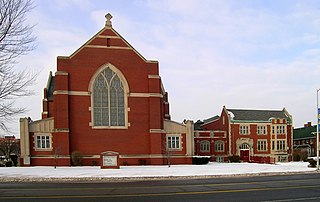
The St. John's Christian Methodist Episcopal Church is a church located in Detroit, Michigan. It was built as the North Woodward Congregational Church, listed on the National Register of Historic Places in 1982, and designated a Michigan State Historic Site in 1998.

The Soul Harvest Ministries is located at 16300 Woodward Avenue in Highland Park, Michigan. It was built in 1916 as the First United Methodist Church and listed on the National Register of Historic Places in 1982.

Christ The King Presbyterian Church is a Presbyterian Church in America (PCA) church, founded in 1995. It occupies the historic building of the former Prospect Congregational Church, located at 99 Prospect Street in Cambridge, Massachusetts near Central Square.

First Lutheran Church is a historic Lutheran church in downtown Dayton, Ohio, United States. Constructed in the 1900s for a large congregation, its architecture includes numerous elements seen in older grand churches, and it has been named a historic site.
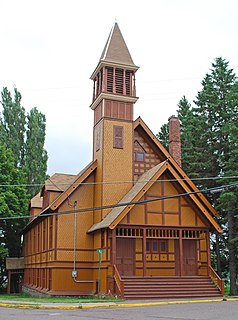
The First Congregational Church is located at 53248 N Avenue in the Linden Lake Historic District in Lake Linden, Michigan. It was listed on the National Register of Historic Places in 1980, and is significant for its impeccable architectural integrity.

The First Presbyterian Church in Batavia, New York, United States, is located at East Main and Liberty streets. It is a joined complex of several buildings. The main one, the church's sanctuary, is a limestone Gothic Revival structure built in the mid-19th century. Its congregation was the first church to be organized in Batavia, albeit as a Congregationalist group at that time.

The Second Congregational Church is a historic church on River Street in Newcastle, Maine. Built in 1848, it is one of Mid Coast Maine's finest examples of brick Gothic Revival architecture. It was listed on the National Register of Historic Places in 1979. The congregation, established in 1843, is affiliated with the United Church of Christ.
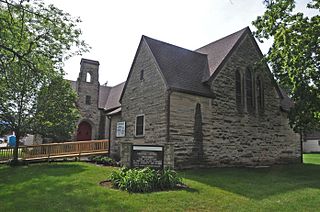
St. Luke's Methodist Church is a Late Gothic Revival church in Monticello, Iowa whose church building was completed in 1950. It is now the Monticello Heritage and Cultural Center. It is the only church in Iowa designed by nationally prominent architects Cram & Ferguson, who specialized in ecclesiastical architecture.
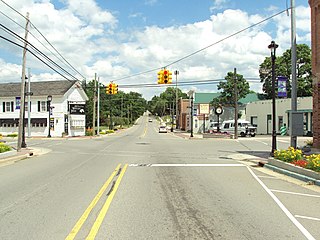
The Metamora Crossroads Historic District is a historic district centered at the intersection of Oak and High Street in the small village of Metamora in Metamora Township in Lapeer County, Michigan. It was designated as a Michigan State Historic Site and also added to the National Register of Historic Places on July 19, 1984.

The Piety Hill Historic District is a historic district located in downtown Lapeer in Lapeer County, Michigan. It was designated as a Michigan State Historic Site and also added to the National Register of Historic Places on July 26, 1985.

First Congregational Church is a historic church building at 165 E. Mill Street in Porterville, California. The church was built in 1908 by Porterville's Congregationalists. San Francisco architects Francis W. Reed and George C. Meeker designed the church; their design applies the principles of the First Bay Tradition to a Gothic Revival plan. The design includes a shingled wooden exterior, typical of the First Bay Tradition, and a Gothic spire and arches; the church is the only building in the southern San Joaquin Valley to incorporate both styles. The new church building served as an "institutional church" which also provided community services, including an auditorium, a gymnasium and swimming pool, and a private kindergarten.

All Souls Congregational Church is an historic church at 10 Broadway in Bangor, Maine. Built in 1911, it is a landmark in the city, designed by the noted proponent of the Gothic Revival, Ralph Adams Cram. It was listed on the National Register of Historic Places in 1992. The church is affiliated with the United Church of Christ; the current pastor is Rev. Chad L. Poland.

The Greenville Downtown Historic District is a commercial historic district located in Greenville, Michigan along Lafayette between Montcalm and Benton, along with the adjacent blocks of Montcalm, Grove, Cass, and Washington on either side. It was listed on the National Register of Historic Places in 2008.
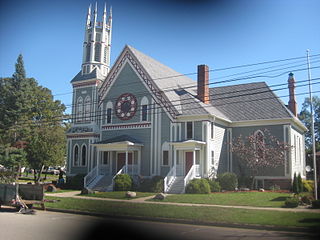
The First Congregational Church of Ovid is a religious building in Ovid, Michigan. It was designated a Michigan State Historic Site in 1971 and listed on the National Register of Historic Places in 1972. Registered Site #: Local Site #0114

The St. John's Congregational Church and Parsonage-Parish for Working Girls are a pair of historic religious buildings at 69 Hancock and 643 Union Streets in Springfield, Massachusetts. The church, built in 1911 for an African-American congregation founded in 1889, is a well-preserved example of English and Gothic Revival architecture. The parsonage, built in 1913, is a little-altered example of Colonial Revival architecture. Both buildings are important in the history of Springfield's African-American community, and were listed on the National Register of Historic Places in 2016. The church building is now occupied by a different congregation, the original having moved to larger quarters across Union Street; the parsonage house continues to be used by the St. John's congregation as an education center.

The First United Methodist Church is a church located at 33112 Grand River Avenue in Farmington, Michigan. It was listed on the National Register of Historic Places in 2014.

The Congregational Church of Plainville is a historic church building at 130 West Main Street in Plainville, Connecticut. Built in 1850, it is one Connecticut architect Henry Austin's significant church designs, exhibiting a mix of Carpenter Gothic and Romanesque features. It was built for a congregation formally organized in 1839 that is now affiliated with the United Church of Christ. The church was listed on the National Register of Historic Places in 2012.






















